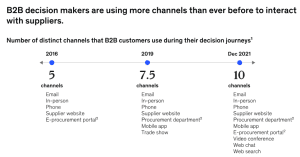News and Insights
From insight to impact: streamlining manufacturing brand messaging
August 19, 2024
According to McKinsey, business-to-business (B2B) buyers are increasingly turning to multiple channels when making work-related purchasing decisions. In 2016, B2B companies had an average of five distinct channels (email, in-person, phone, supplier website and e-procurement portal); now, that figure has risen to ten. To excel in omnichannel marketing, it’s essential to ensure customers can seamlessly transition between channels without losing context or repeating information. For example, B2B companies that successfully embed omnichannel show earnings before interest and taxes (EBIT) growth of 13.5 percent, compared to the 1.8 percent achieved by less digitally enabled peers.

Source: McKinsey, Next-gen B2B sales
For manufacturing companies with a diverse and complex product portfolio, it’s crucial that all customer and partner-facing members can consistently communicate the brand’s core value propositions and key messaging. The brand essence—rooted in customer needs, market trends, competitor differentiators, and strategic imperatives—should resonate across all platforms, regardless of where prospects and customers are in their purchasing journey.
At FINN Partners, a proven framework is used to synthesise research and insights into simple, effective brand messaging. This clear messaging allows all users and deliverers of the brand to be efficient, effective, and consistent from top to bottom. The challenge is ensuring that all company representatives engaging with customers and stakeholders can articulate the company’s expertise, experience, and unique position in the industry. A strong and consistent set of messages across all communication channels is essential for differentiation.
Discovery
The process begins with a thorough analysis of the brand market position and research to inform strategy. This robust understanding of current market trends and where the manufacturing brand fits is foundational to developing effective messaging. A range of research sources, including market reports, industry statistics, surveys, and trend analyses, are used.
Following the research phase, input is gathered from within the organisation, engaging individuals from the C-Suite: marketing specialists, the sales team, engineers, R&D personnel, and HR. Understanding internal perceptions is vital, as there are often opposing views within the organisation. Opening these debates helps drill down into the facts to reach a consensus on market presentation, ensuring all involved are confident in the strategy.
Synthesis
Once discussions are held and research is collated and analysed, the next step is creating the messaging and positioning platform—or message house. This framework presents the core pillars of the market approach such as technical expertise, sustainability, service capabilities, and product development. It includes the foundation of the business and the umbrella statement or elevator pitch. Depending on the exercise, this can also incorporate a new tagline for rebranding, refreshing, or new product launches.
The messaging framework, developed based on research, consolidates the brand’s core values and market proposition. It offers guidance on tone of voice, content creation, and communication channels and outlines the key market messages that will resonate with external stakeholders.
Roll-out
Implementation of the messaging into the marketing and communications strategy follows. Everything identified and outlined in the message house must be applied across all points of contact—such as the website, social media channels, marketing and PR communications in print and online, and direct interactions with customers and prospects. This implementation reveals the true value of differentiated messaging and positioning.
Interactions and share of voice should increase, presenting customers and prospects with a fresh approach to their challenges, driving inquiries and, ultimately, sales. Guidance on supporting the delivery of the messaging includes defining core messages and talking points for each pillar based on the stage of the customer journey—awareness, consideration, or decision—to aid in the development of future content.
For more information on how FINN Partners can help you stand out in the manufacturing space, contact Yulia Tribrat at yulia.tribrat@finnpartners.com.
Photo Credit: Mikhail Nilov/Pexels
